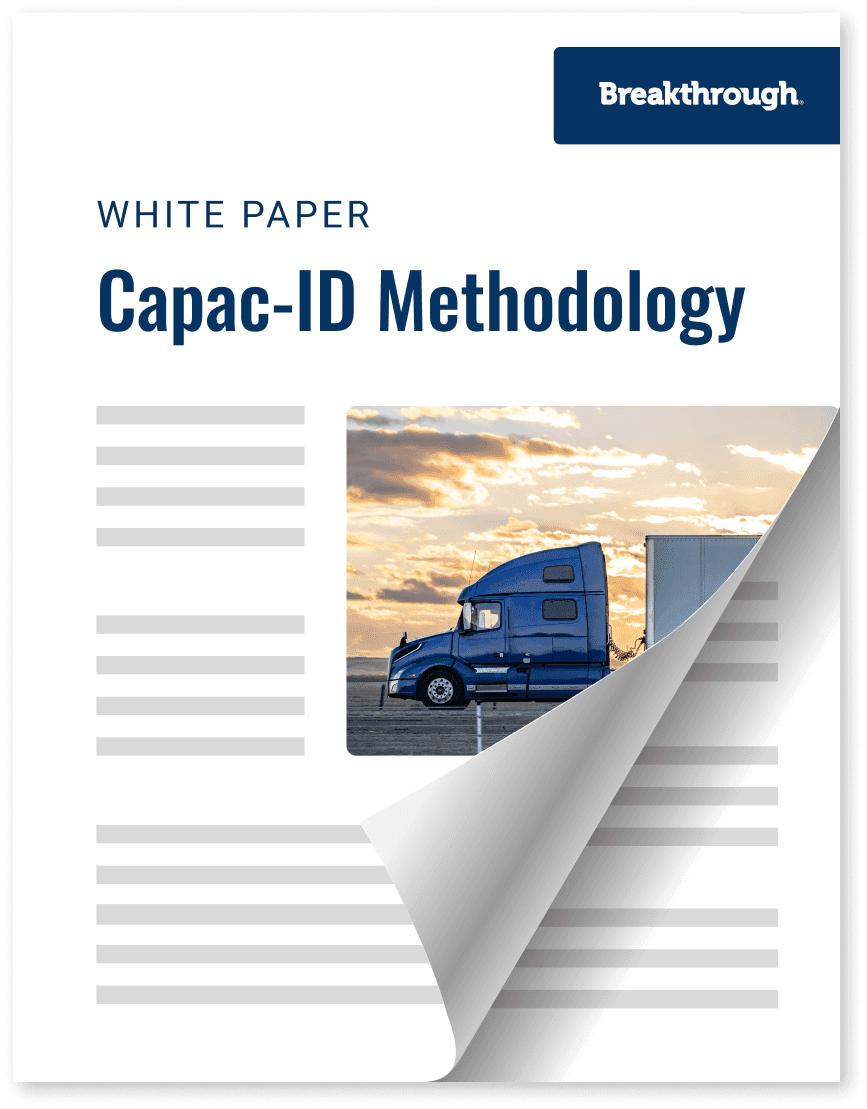Breakthrough’s Capac-ID Methodology

Trending
Top Posts
7 min read
May 17, 2019

Share:
Table of contents
Browse the table of contents to jump straight to the part you’re looking for
Volatility in the fuel market, carrier activity, and a host of other factors have the power to dramatically impact shippers’ budgets. Diving into historical trends and past data helps better understand these phenomena but staying informed of present trends and predicting how they may impact the future fuels better forward-looking strategies.
At Breakthrough, both our fuel management and supply chain solutions emphasize that when shippers have a clear, unbiased view of their network – and how price movement may impact it over time – this knowledge empowers them to make well-informed, strategic decisions. Though forecasting may have different applications when related to fuel or freight, it is a core component of both facets of the Breakthrough Experience.
To demonstrate what forecasting means to both areas of our business, Chief Operating Officers Jenny Vander Zanden and Heather Mueller explain below how it allows shippers to inform their forward-looking strategies even in a seemingly unpredictable transportation marketplace.
Fuel is an inherently volatile portion of the total cost of moving products to market, representing between twenty-five to thirty percent of that spend. In the past five years this has been especially apparent, as there have been multiple market forces that resulted in periods of significant decline, short abrupt spikes, and rising prices. From an overall supply chain cost perspective this is critical. Year-over-year changes in fuel price can drive changes in total spend, which can dramatically impact overall profitability.
To help our clients account for this volatility, our monthly market Advisor publications offer an in-depth forecast and forward-looking perspective on the market, monitoring the impact key events and economic indicators have on price. This knowledge can then be used by our clients to create more accurate budgets in their respective organizations.
Geopolitical risk, global economic outlook, and supply and demand fundamentals ground our fuel forecasting perspective to help clients contextualize and understand the price environment they experience. Our forecast accuracy is historically very high, nearly 98%, and when paired with a market-based approach to fuel reimbursement, helps shippers become less subject to the huge swings that can happen with an index-based fuel reimbursement program like the DOE. With this, they have certainty that they are reimbursing for fuel based on the underlying market behavior and are in alignment with well- managed carriers.

Another unique aspect of this approach is that we get to act as an extension of our clients’ team. Most of our clients have not historically possessed individual transportation energy experts on their procurement or operations teams. With our solution, our clients have the information they need at their fingertips to describe market changes to their organizations, without needing to dedicate extra time to research. This is not about just giving them a number to report either, but rather an outlook they can distill into key points and executive summaries.
Our forecasting also incorporates our close pulse of the changing tax landscape. We have the ability to model how pending tax changes will impact our clients’ unique transportation budgets based on their actual network data. Many companies that are not thinking strategically about the energy they consume don’t have access to the specific cost impacts of these types of changes which can create significant distortion in their transportation fuel spend.
We continue to update these forecasts monthly, so clients have the most up-to-date information on the market. Shippers not utilizing Breakthrough have often not thought about the total gallons they consume, much less how those gallons fit into their budgeting practices. Our technology, paired with robust forecasting, provides a window into what fuel expense is going to look like for a shipper in the future.
This has the added benefit of helping identify other potential areas of savings. While forecasting is important for annual budget, another benefit of Fuel Recovery is that it moves with the market, so forecasting risk is minimized. If a shipper does not appear to be on track to hit their forecast, we can also show them new opportunities for savings to improve.
Although historically shippers may not be as familiar with fuel forecasting, there is a huge emphasis in the industry put on freight forecasting, and transportation forecasting overall. This process can be tricky as there are many distinct dynamics to consider.
For example, in 2018 we saw that when capacity tightens and the market swings upward, shippers can miss their budgets by significant amounts. When working through this environment with our clients, we saw that many other publicly-traded companies cited missing their transportation budgets in earnings reports. This is a large indicator of a forecasting issue.
Transportation forecasting is also generally tied to an RFP cycle, and these processes are imperfect and often unsustainable. What we see in our clients is that degradation in carrier consistency occurs when the bid falls apart, and that bid is what sets the transportation budget. If you are not consistently measuring and adjusting to what’s happening in the market after the bid, the budget you create is going to erode over time because your routing guide erodes over time. So, four weeks out from a bid, we see consistency decrease between 10-15 percent during this period. Right now, because of our approach to ongoing transportation management, we are operating within one percent variation from budget with a Breakthrough Supply Chain client.
Despite being driven by supply and demand principles, transportation does not operate like a traditional commodities market. Market sentiment plays a much larger role in this environment, so understanding what drives this is critical. Unlike in traditional economic markets, headlines can notably drive price, so being able to understand what is real, and what is not, allows more data-driven, as opposed to story-driven, freight strategies.
Headlines are especially impactful in markets that are relatively balanced. When we think about what happens in oil markets, for example, if we’re in a market of over-supply, then supply and demand fundamentals drive price movement. If we are in a market that is relatively balanced, however, news headlines about geopolitical risk or economic uncertainty tend to drive price instead. In this way, stories create volatility and the same is true in the freight market.

At Breakthrough, one thing we are doing to account for this volatility is building out our ability to create a demand index. Ultimately, our shipper clients are what drive demand, and demand is – when you look at economic markets – what drives price. Right now, we’re seeing the inverse of that in the freight market—supply and news headlines are driving price.
Shippers have freight, freight drives demand, and if we can forecast and have a better idea of what demand looks like, we can then have a more informed conversation about what price looks like, and whether it is sustainable. This resembles how we speak to the fuel side of our business: ultimately the shipper is economically responsible for this cost. As such, they should be the ones controlling it. It’s a market, so there are many dynamics that can change price, but if shippers are informed about that price they are able to have better command of it.

5 min read
January 2, 2026
Stay ahead of Q1 2026 diesel fuel tax by state adjustments. See how changes in states like MI and NJ will impact your transportation spend.
Read more
6 min read
January 1, 2026
Learn what a fleet card is, how they work, and the top fleet card benefits. Our guide explains how the right fleet card program can save you money.
Read more
5 min read
December 31, 2025
Discover how to implement a mobile fueling program that boosts fleet efficiency and cuts costs. Our guide covers evaluation, partner selection, and integration.
Read more